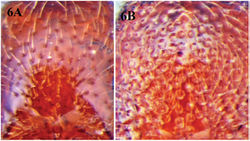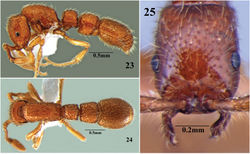Cerapachys schoedli
| Notice: | This page is derived from the original publication listed below, whose author(s) should always be credited. Further contributors may edit and improve the content of this page and, consequently, need to be credited as well (see page history). Any assessment of factual correctness requires a careful review of the original article as well as of subsequent contributions.
If you are uncertain whether your planned contribution is correct or not, we suggest that you use the associated discussion page instead of editing the page directly. This page should be cited as follows (rationale):
Citation formats to copy and paste
BibTeX: @article{Bharti2013ZooKeys336, RIS/ Endnote: TY - JOUR Wikipedia/ Citizendium: <ref name="Bharti2013ZooKeys336">{{Citation See also the citation download page at the journal. |
Ordo: Hymenoptera
Familia: Formicidae
Genus: Cerapachys
Name
Cerapachys schoedli Bharti & Akbar, 2013 sp. n. – Wikispecies link – ZooBank link – Pensoft Profile
Type material
Holotype worker: India. Kerala, Silent valley national park, 11°5'N, 76°26'E, 897m a.s.l., 25.ix.2011, Winkler. Paratypes: 13 workers and 3 ergatoid queens, same data as holotype; 2 workers, India, Kerala, Salim Ali Bird Sanctuary, 10°45'N, 76°44'E, 118m a.s.l., 6.xi.2011, Winkler; 10 workers, India, Kerala, Periyar tiger reserve, Manalar, 9°35'N, 77°18'E, 1630m a.s.l., 27.x.2011, hand picking (coll. Shahid A. Akbar). Holotype in PUAC and paratype in BMNH.
Worker description
Measurements (holotype in brackets): HL 0.64-0.68 (0.68); HW 0.44-0.46 (0.46); EL 0.07-0.11 (0.11); WL 0.62-0.69 (0.69); MH 0.41-0.48 (0.48); PrW 0.31-0.35 (0.35); PL1 0.24-0.27 (0.27); PW1 0.28-0.31 (0.31); IIIAL 0.28-0.32 (0.32); IIIAW 0.39-0.41 (0.41); SL 0.31-0.33 (0.33); IVAL 0.70-0.74 (0.74); IVAW 0.58-0.60 (0.60). Indices: CI 67-69 (67); SI 70-72 (72); PI 114-116 (114) (n=11).
Head, rectangular, longer than broad; sides parallel; vertexal border transverse. Posterior lateral corners acute. Parafrontal ridges present, raised. Eyes medium sized, almost circular. Mandibles subtriangular; masticatory margins without a row of small denticles. Lateroclypeal teeth small. Antennae 12 segmented; scapes short, each falling short of posterior margin of head by 1/3rd of its length.
Mesosoma. stout, humped in profile view; dorsal surface convex, continuous with sides, no lateral margins. Declivous face of propodeum with cariniform margins across the top and along the lateral margins.
Metasoma. Petiole broader than long, and gently rounded towards the sides. Anterior and posterior faces transverse. Subpetiolar process stout, fenestra present. Postpetiole almost rectangular, wider behind, with the posterolateral angles not tuberculate but uniformly rounded. Gaster elongate; base of cinctus of first gastral tergite with cross ribs; sting exerted.
Sculpture. Mandibles with small punctures. Head smooth and shining with some punctures. Mesosoma mostly smooth and shining with some punctures along the sides. Petiole, postpetiole and gaster with continuous punctures.
Vestiture. Body covered with moderate, decumbent or subdecumbent hairs, most prominent on gaster; apical funicular segments and legs also with standing hairs.
Colour. Bright yellowish orange to dark red.
Ergatoid queen measurements
HL 0.80-0.84; HW 0.59-0.63; EL 0.14-0.16; WL 0.88-0.92; MH 0.51-0.55; PrW 0.49-0.53; SL 0.41-0.43; PL1 0.29-0.31; PW1 0.38-0.41; IIIAL 0.44-0.50; IIIAW 0.57-0.59; IVAL 0.88-0.90; IVAW 0.86-0.88. Indices: CI 73-75; SI 68-69; PI 131-132 (n=3).
Like the workers of the same colony, but larger, with more stout body, especially the mesosoma and gaster. Ocelli absent on vertex. Distinction between ergatoid queens and worker is vague, with size variation of workers very high.
Etymology
The species is named in the honor of the late Dr. Stefan Schödl.
Differential diagnosis
This species is aberrant in many characters, with the cephalic dorsum bearing small punctures with average diameter lesser than the average distance separating them, a highly shinning body and reduced body sculpture, which separates it from other reported Indian species. Cerapachys schoedli sharesmost characters with Cerapachys seema, from which it can be easily distinguished by the combination of characters given in the diagnosis of the latter species. The new species can also be compared with Cerapachys luteoviger Brown, 1975 which also has small punctures on the cephalic dorsum, with diameter lesser than the average distance separating them. However, the peculiar petiolar node (with anterodorsal border concavely emarginate) and rounded head shape of Cerapachys luteoviger easily separates it from Cerapachys schoedli, which has the petiolar node broader than long and the posterior lateral corners of the head acute.
Ecology
This species seems to be common in the Western Ghats; it was collected in non-forest as well as forest habitats in leaf litter and on dry soil surfaces.
Original Description
- Bharti, H; Akbar, S; 2013: Taxonomic studies on the ant genus Cerapachys Smith (Hymenoptera, Formicidae) from India ZooKeys, 336: 79-103. doi
Images
|





